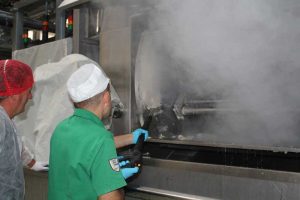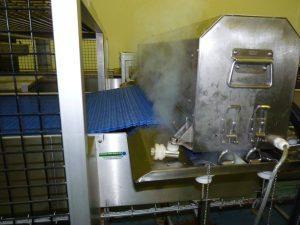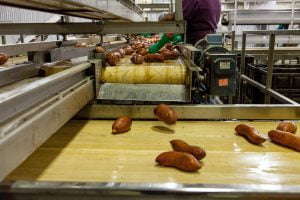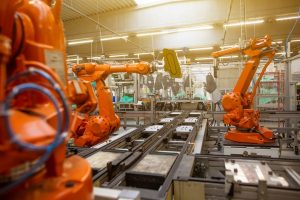Poor conveyor belt cleaning poses several risks in food plants. One of the main risks is contamination. When conveyor belts are not properly cleaned, they can become a breeding ground for bacteria, mold, and other contaminants. These contaminants can then transfer onto the food products being transported on the belts, leading to spoilage and potential health risks for consumers.
Contamination can occur from various sources, including raw ingredients that may contain harmful bacteria or pathogens. If these contaminants are not effectively removed from the conveyor belts, they can contaminate other products that come into contact with the belts during the production process. This can result in product recalls, loss of consumer trust, and potential legal consequences for the food plant.
In addition to contamination risks, poor conveyor belt cleaning can also lead to product spoilage. Contaminants on the belts can cause food products to deteriorate more quickly, reducing their shelf life and quality. This can result in financial losses for the food plant as spoiled products may need to be discarded or sold at a reduced price.
Furthermore, dirty conveyor belts can pose safety hazards for workers. Contaminants on the belts can make them slippery, increasing the risk of slips, trips, and falls. This can lead to injuries and downtime for the food plant. Therefore, it is crucial for food plant operators to prioritize regular and effective conveyor belt cleaning to mitigate these risks.
Factors to Consider When Choosing a Conveyor Belt Cleaning System
When choosing a conveyor belt cleaning system, there are several factors that food plant operators should consider. Firstly, it is important to select a system that is appropriate for the specific needs of the food plant. This includes considering factors such as the size of the plant, the type of conveyor belts used, and the cleaning frequency required.
The size of the food plant will determine the capacity and capabilities needed for the conveyor belt cleaning system. Larger plants may require more powerful and efficient systems to effectively clean their conveyor belts. On the other hand, smaller plants may be able to use simpler and less expensive systems.
The type of conveyor belts used in the food plant is also an important consideration. Different materials require different cleaning methods and equipment. For example, belts made of fabric may require a different cleaning approach compared to belts made of stainless steel. It is important to choose a system that is compatible with the specific type of conveyor belts used in the food plant.
Lastly, the cleaning frequency required should also be taken into account when choosing a conveyor belt cleaning system. Some systems may require more frequent cleaning or maintenance, which can impact production efficiency. It is important to strike a balance between effective cleaning and minimizing downtime for the food plant.
The Advantages of Steam Vapour Cleaning Machines for Conveyor Belts
Steam vapour cleaning machines are an effective option for cleaning conveyor belts in food plants. These machines use high-temperature steam to remove contaminants from the belts, providing a thorough and efficient cleaning process. There are several benefits to using steam vapour cleaning machines for conveyor belts.
One of the main advantages of steam vapour cleaning machines is their ability to sanitize and disinfect. The high-temperature steam kills bacteria, mold, and other pathogens, ensuring that the conveyor belts are thoroughly cleaned and free from harmful contaminants. This helps to maintain food safety and prevent product spoilage.
In addition to sanitizing, steam vapour cleaning machines also provide a chemical-free cleaning solution. The high-temperature steam is effective in removing grease, oil, and other stubborn stains without the need for harsh chemicals. This is particularly important in food plants where chemical residues can pose a risk to food safety.
Furthermore, steam vapour cleaning machines are versatile and can be used on various types of conveyor belts. They can effectively clean belts made of fabric, plastic, or stainless steel, making them suitable for different food plant applications. This versatility makes steam vapour cleaning machines a cost-effective option for food plant operators.
How Steam Vapour Cleaning Machines Work: The Science Behind the Cleaning Process
| Advantages of Steam Vapour Cleaning Machines for Conveyor Belts |
|---|
| 1. Efficiently removes dirt, grease and grime from conveyor belts |
| 2. Reduces the need for harsh chemicals and detergents |
| 3. Kills bacteria and germs, improving hygiene and safety |
| 4. Saves water compared to traditional cleaning methods |
| 5. Increases the lifespan of conveyor belts by preventing damage from abrasive cleaning methods |
| 6. Improves overall efficiency and productivity of conveyor systems |
Steam vapour cleaning machines work by using high-temperature steam to remove contaminants from conveyor belts. The science behind the cleaning process involves several key principles.
Firstly, the high-temperature steam softens and loosens dirt, grease, and other contaminants on the conveyor belts. The heat breaks down the bonds between the contaminants and the belt surface, making it easier to remove them.
Secondly, the steam penetrates into the pores of the conveyor belts, reaching areas that may be difficult to clean with other methods. This ensures a thorough cleaning process and helps to remove any hidden contaminants that may be present.
Lastly, the high-temperature steam kills bacteria, mold, and other pathogens on the conveyor belts. The heat denatures the proteins in these microorganisms, effectively destroying them and preventing their growth. This helps to maintain food safety and prevent the spread of harmful contaminants.
Overall, the combination of high-temperature steam, heat, and pressure in steam vapour cleaning machines provides an effective and efficient cleaning process for conveyor belts in food plants.
The Benefits of Using Automatic Conveyor Belt Steam Vacuum Systems
Automatic conveyor belt steam vacuum systems offer several benefits for food plants. These systems combine the cleaning power of steam vapour with the convenience of automated operation, improving efficiency and reducing labor costs.
One of the main benefits of using automatic conveyor belt steam vacuum systems is their ability to clean large areas quickly and effectively. These systems are designed to cover a wide surface area, allowing for efficient cleaning of conveyor belts. The automated operation ensures consistent and thorough cleaning, reducing the risk of missed spots or incomplete cleaning.
Furthermore, automatic conveyor belt steam vacuum systems can help to reduce labor costs. These systems require minimal manual intervention, allowing workers to focus on other tasks while the cleaning process is underway. This can lead to increased productivity and efficiency in the food plant.
Additionally, automatic conveyor belt steam vacuum systems are designed to be user-friendly and easy to operate. They often come with intuitive controls and features that make them accessible to operators with varying levels of experience. This reduces the need for extensive training and ensures that the system can be used effectively by all staff members.
Types of Conveyor Belt Cleaning Systems: Pros and Cons

There are several types of conveyor belt cleaning systems available, each with its own pros and cons. The choice of system will depend on factors such as the specific needs of the food plant, the type of conveyor belts used, and the cleaning frequency required.
One common type of conveyor belt cleaning system is a brush cleaner. These systems use rotating brushes to scrub the conveyor belts and remove contaminants. Brush cleaners are effective in removing loose debris and particles from the belts. However, they may not be as effective in removing stubborn stains or sanitizing the belts.
Another type of conveyor belt cleaning system is a scraper cleaner. These systems use blades or scrapers to remove contaminants from the belts. Scraper cleaners are effective in removing sticky substances such as grease or oil. However, they may not be suitable for all types of conveyor belts, as they can cause damage or wear on certain materials.
Steam vapour cleaning machines, as discussed earlier, are another type of conveyor belt cleaning system. These machines use high-temperature steam to sanitize and remove contaminants from the belts. Steam vapour cleaning machines are versatile and effective in removing a wide range of contaminants. However, they may require more initial investment compared to other types of systems.
It is important for food plant operators to carefully consider the pros and cons of each type of conveyor belt cleaning system and choose the one that best fits their specific needs and requirements.
Maintenance and Cost Considerations for Conveyor Belt Cleaning Systems
Regular maintenance is essential for ensuring the effectiveness and longevity of conveyor belt cleaning systems. Proper maintenance helps to prevent breakdowns, reduce downtime, and extend the lifespan of the equipment. It is important for food plant operators to establish a maintenance schedule and follow manufacturer guidelines for cleaning and servicing the system.
The costs associated with conveyor belt cleaning systems can vary depending on factors such as the type of system, the size of the food plant, and the specific needs of the plant. It is important to consider both the initial investment cost and the ongoing maintenance costs when choosing a system.
Some systems may require more frequent maintenance or replacement of parts, which can increase the overall cost over time. On the other hand, investing in a high-quality system upfront may result in lower maintenance costs and longer lifespan.
It is also important to consider the potential cost savings that can be achieved through effective conveyor belt cleaning. By preventing product spoilage, reducing downtime, and maintaining food safety, a well-maintained conveyor belt cleaning system can help to save costs in the long run.
Choosing the Right Conveyor Belt Cleaning System for Your Food Plant: A Step-by-Step Guide
Choosing the right conveyor belt cleaning system for a food plant requires careful consideration of several factors. Here is a step-by-step guide to help food plant operators make an informed decision:
1. Assess the specific needs of the food plant: Consider factors such as the size of the plant, the type of conveyor belts used, and the cleaning frequency required.
2. Research different types of conveyor belt cleaning systems: Explore the pros and cons of each type of system, including brush cleaners, scraper cleaners, and steam vapour cleaning machines.
3. Consider the compatibility with conveyor belt material: Ensure that the chosen system is compatible with the specific type of conveyor belts used in the food plant. Different materials may require different cleaning methods and equipment.
4. Evaluate the cleaning capabilities: Assess the effectiveness of each system in removing contaminants and sanitizing the belts. Consider factors such as temperature, pressure, and cleaning method.
5. Consider maintenance requirements: Evaluate the maintenance needs of each system, including frequency of servicing and replacement parts. Consider both initial investment cost and ongoing maintenance costs.
6. Determine the budget: Set a budget for the conveyor belt cleaning system, taking into account both upfront costs and long-term savings.
7. Seek recommendations and reviews: Consult with industry experts or other food plant operators to gather recommendations and reviews on different systems.
8. Request demonstrations or trials: If possible, request demonstrations or trials of the chosen systems to assess their performance and suitability for the food plant.
9. Make an informed decision: Based on the assessment of all factors, choose the conveyor belt cleaning system that best fits the specific needs and requirements of the food plant.
Investing in the Right Conveyor Belt Cleaning System for Long-Term Success
Investing in the right conveyor belt cleaning system is crucial for long-term success in food plants. Contaminated conveyor belts can lead to product spoilage and safety hazards, compromising the quality and safety of food products. By prioritizing regular and effective cleaning, food plant operators can maintain food safety, prevent product spoilage, and reduce the risk of accidents.
Steam vapour cleaning machines and automatic conveyor belt steam vacuum systems offer several advantages for cleaning conveyor belts. These systems provide thorough cleaning, sanitization, and disinfection, ensuring that the belts are free from contaminants. They also offer efficiency and labor cost savings through automated operation.
When choosing a conveyor belt cleaning system, it is important to consider factors such as the specific needs of the food plant, the type of conveyor belts used, and the cleaning frequency required. By following a step-by-step guide and considering all relevant factors, food plant operators can make an informed decision and invest in the right conveyor belt cleaning system for long-term success.
FAQs
What is a conveyor belt cleaning system?
A conveyor belt cleaning system is a device or set of devices used to clean conveyor belts in food facilities. It is designed to remove debris, dirt, and other contaminants from the conveyor belt to ensure that the food products are not contaminated during the production process.
Why is it important to choose the right conveyor belt cleaning system?
Choosing the right conveyor belt cleaning system is important because it ensures that the conveyor belt is cleaned effectively and efficiently. This helps to prevent contamination of food products, which can lead to foodborne illnesses and other health hazards.
What factors should be considered when choosing a conveyor belt cleaning system?
When choosing a conveyor belt cleaning system, factors such as the type of food being produced, the size and speed of the conveyor belt, the type of contaminants present, and the cleaning requirements of the facility should be considered.
What are the different types of conveyor belt cleaning systems?
There are several types of conveyor belt cleaning systems, including brush cleaners, scraper cleaners, air knives, and steam cleaners. Each type of system has its own advantages and disadvantages, and the choice of system will depend on the specific needs of the facility.
How do brush cleaners work?
Brush cleaners use rotating brushes to scrub the conveyor belt and remove debris and contaminants. They are effective for removing loose debris and are often used in facilities that produce dry food products.
How do scraper cleaners work?
Scraper cleaners use a blade or scraper to remove debris and contaminants from the conveyor belt. They are effective for removing stubborn debris and are often used in facilities that produce wet or sticky food products.
How do air knives work?
Air knives use compressed air to blow debris and contaminants off the conveyor belt. They are effective for removing loose debris and are often used in facilities that produce dry food products.
How do steam cleaners work?
Steam cleaners use high-pressure steam to clean and sanitize the conveyor belt. They are effective for removing stubborn debris and killing bacteria and other pathogens. They are often used in facilities that require high levels of sanitation.









